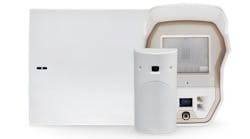When it comes to the smart home, all of the naysayers who once greeted it with contempt have faded into the background, as the technology gains more and more momentum among consumers, security vendors, and yes, even security dealers as well.
“This is a really exciting time for the security industry,” says Donald Gantt Jr., president of Integrated Electronic Technologies of Mobile, Ala. “Smart home technologies are finally gaining universal acceptance, and advancements in mobile technologies are creating solutions straight out of science fiction.”
The beauty and allure of the smart home market for us is of course the fact that it centers around security, as countless research reports and surveys have confirmed. Furthermore, the smart home market is still in its infancy; in fact, according to a recent survey of more than 1,000 U.S. consumers conducted by NextMarket Insights on behalf of August Home and Xfinity Home, smart home market penetration as of April 2016 was less than 14 percent — that gives our industry a lot of potential new customers.
For the first time this year, a residential-focused security dealer sat atop the SD&I Fast50. That dealer — NorthStar Home of Utah — is certainly not focusing on traditional alarm installations. Of course, they are laser-focused on the connected home. Straight out of NorthStar’s marketing materials: “A smart home is a NorthStar home. It's revolutionary technology that puts your home at your fingertips, making it more secure, convenient and comfortable. You'll be surprised how affordable it can be.”
Our Fast50 also revealed a major spike in interest in smart homes, specifically among security dealers and integrators. Our 2015 market research revealed that just over 3 percent of surveyed companies viewed smart homes as a security trend that concerned them most. This year, that number leaped to nearly 25 percent. Our 2015 survey also revealed that only about 4 percent of security dealers and integrators were interested in adding home automation and lifestyle technologies to their offerings. This year that number surged to 27 percent. Even panic alarms and mobile PERS devices jumped from less than 2 percent to 10 percent.
Clearly, manufacturers are helping this trend push forward as well, thanks to new offerings. All of the top residential security providers — from ADT to Alarm.com, Honeywell, UTC, Resolution Products and beyond — now have a smart home platform that dealers can leverage among its customers.
Purchasing Motivations
The first step to selling smart homes is understanding the smart home users and their motivations. While it is true that the Millennial generation are the leading adopters of the technology, there are still plenty of consumers who are interested.
According to the August Home/Xfinity Home survey, there are two dominating factors among consumers that lead to smart home product adoption. The first will obviously ring true with security dealers, as 46 percent said a break-in or related crime in their neighborhood would most likely inspire them to purchase a smart home product — further cementing the importance of security when it comes to smart home purchasing decisions. The second factor reveals an interesting sales opportunity, and 26 percent said moving into a new home would prompt the purchasing decision.
The survey also revealed that the top two most compelling smart home features are firmly grounded in security. Number one (64 percent) is the ability to monitor the residence while home or away via Internet-connected video cameras; number two (62 percent) is the ability to monitor, arm and receive alerts from the home security system via mobile app.
“Security and peace-of-mind reign supreme during the decision-making process and are top motivating factors for customer retention, with general security concerns and specific security events being the top reasons most people purchase a system in the first place,” according to Icontrol Networks’ do-it-for-me (DIFM) Smart Home Survey of more than 550 smart home technology users across seven different brands.
The survey went on to cite approximately 70 percent of total respondents use security system arming/disarming, video cameras and door lock control once a week or more. “DIFM smart home technology platforms have the capacity to take on myriad devices that cover appliances, entertainment, health and fitness and more to create true whole home automation,” Icontrol CEO Bob Hagerty said in a statement. “The emerging opportunity for DIFM service providers is to educate customers on the possibilities.”
“As connected home systems become the new normal, make sure you offer solutions and services that meet changing expectations,” adds Blake Deal, Residential Sales Director for Lutron Electronics.
The Typical Smart Home Users
In its smart home research (http://punchcut.com/perspectives/unlocking-the-connected-home-smart-home-research), Punchcut, a design company that works with the world's top companies to envision, design and realize next-generation digital products and services, identified six typical smart home users:
The Renaissance Millennial has a smart thermostat in her newly renovated one-bedroom rental apartment. On a hot day, she loves being able to adjust the AC via app when she’s on her way home, so it is nice and cool when she gets there. She is even more excited by the device’s ability to adapt to her unique behavior patterns through a learning algorithm.
The Neighborhood Detective vigilantly uses video cameras to monitor crime in his area. He proactively records vandals breaking into cars on his busy street, shares the footage with the local police department and frequently catches the perpetrators — an act of security which is greatly valued by his local community.
The DIY geek is determined to install and configure the smart home devices (i.e., lighting, locks, thermostat, fan) himself in his multi-level condo. But attempting to achieve an interconnected system, where each of the devices talk to each other, has been a complex and daunting undertaking — one that has required an exhaustive amount of time and money.
The Green Evangelist has efficiency and sustainability at the top of her mind. Her home is powered by solar panels and she drives an electric car. She values seeing energy savings on her monthly electricity bill.
The Practical Family Man is enticed by the promise of smart home technology and has recently been caught up in the “euphoria of connectivity.” He considers himself to be an early adopter of technology, but at a low price point. He is very cost-conscious and every home purchase is evaluated based on its return on investment.
The Mama Bear prioritizes convenience above all else. Her child’s safety and whereabouts is her utmost concern, which is why multiple cameras are set up throughout her house. She needs everything (i.e., cameras, lights, thermostat, garage, etc.) conveniently controlled by the press of a button and easily accessible on her phone with one app.
Looking at these six users, each certainly deserves a customized sales pitch. “No one size fits all when it comes to the smart home, and consumers want the option to choose what fits their lifestyles and needs,” Hagerty confirms.
Fortunately for security dealers, vendors have noticed the variety of end-user in this market and are developing solutions to address each one. Plenty of vendors —both in the security industry and outside of it —have cool gadgets to impress the Millennial. Every vendor now offers easy-to-use cameras to satisfy the neighborhood detective. Most smart home security product lines include a smart thermostat and similar devices to satisfy the green evangelist.
While some research still cites cost as a barrier to smart home adoption, the right strategy and dealer can help convince the family man. “Security is fundamental to our business, but we feel like we are leading out on presenting new connected home technologies to our new customers and actively marketing to our current customers on how to add new technology to their systems,” says Jason Christensen, CEO of NorthStar Home. “The consumer is able to benefit so much more and essentially this technology and additional services and value come at a similar cost.”
Courting the DIY Customer
The final — and perhaps the most perplexing user for security dealers — has been the DIY geek. But the security industry is stepping up to help these users as well, with do-it-yourself installed systems that come with built-in monthly monitoring packages to ensure RMR for both the vendor and the dealer.
The RSI DragonFly Security System — the brainchild of Videofied (recently acquired by Honeywell) founder Keith Jentoft is one such system. It includes self-installed indoor and outdoor battery-powered wireless video cameras that are professionally monitored and deliver fast police response — all while the dealer collects RMR.
Security Dealer Network (SDN), a new business venture created by security industry veteran Bart Didden and founded specifically for the DragonFly product, offers alarm dealers the opportunity to become part of its sales network and receive RMR by offering the equipment.
“We’ve made DragonFly as easy as possible for dealers,” Didden says. “All they need to do is sign up and sell. We provide the marketing tools, a branded internet landing page, an e-commerce website for customer fulfillment, the app and the video monitoring. It is a no risk proposition that enables dealers to get a share of a growing consumer DIY market that would otherwise be lost to them.”
Dealers get a branded website where consumers purchase the products directly. Orders are shipped for free directly to the consumer and SDN provides the central station monitoring, with both companies sharing the RMR.
The key to this and other similar DIY-type systems for dealers is selling the value of central monitoring. After all, what good is a security system if police or fire cannot be dispatched efficiently?
Reaping the Rewards
“When dealers expand the traditional idea of a security system to include a broad spectrum of connected home products and services, their customers enjoy enhanced peace of mind, reduced energy bills and improved comfort and convenience,” Lutron’s Deal says. Dealers reap the rewards as well, including higher RMR, higher contract renewal, lower attrition and greater satisfaction with the system.
The August Home/Xfinity Home survey predicts the smart home adoption rate to double in the next 12 months. Residential security dealers must embrace this new paradigm or risk being left in its wake.
About the Author: Paul Rothman is Editor in Chief of Security Dealer & Integrator (SD&I) magazine. To access the current issue and digital archives, please visit www.secdealer.com.







